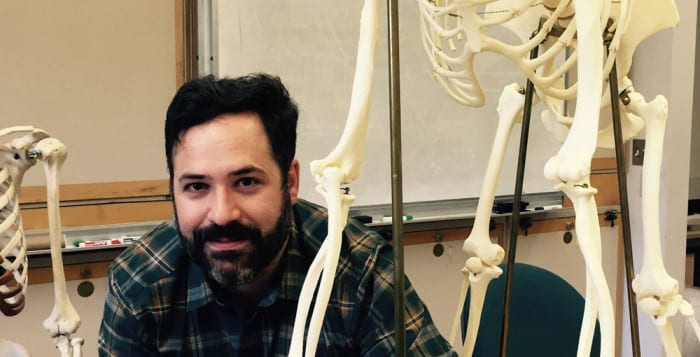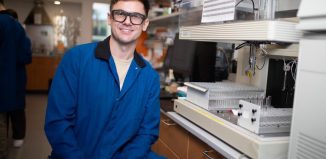Chimpanzees could give humans an evolutionary hand

He’s at it again.
Sergio Almécija ruffled feathers in 2013 when he looked at the femur bone of an ape that lived six million years ago and suggested that this leg bone might have been like that of a fossil ape, which upset the usual human evolution story. Almécija, who left his post as research instructor at Stony Brook University this summer and joined George Washington University in Washington D.C. as an assistant professor in the Department of Anthropology, recently compared the hands of humans with chimps and apes. His findings and possible conclusions have, once again, challenged some conventional wisdom.
In looking at hand bones, Almécija, working with Jeroen Smaers and William Jungers at Stony Brook, analyzed the length of thumbs compared with fingers. He discovered that human hands haven’t changed that dramatically over the last several million years, while those of chimpanzees have shown considerably more variation, with the length of their fingers getting longer relative to their thumbs. He published this research recently in the journal Nature Communications.
“The generally accepted hypothesis is that our hand proportions went through dramatic changes, starting from a chimp-like hand with long digits and relatively short thumb by means of selective pressure,” Almécija explained. This process would have started about three million years ago, when humans produced stone tools in a systematic way. Almécija’s analysis, however, suggests the most likely scenario is one in which humans changed little, with our fingers slightly shorter and thumbs slightly longer, than our ancestors, while chimps have had elongated digits to help them move around in trees.
“Humans are very good at using their hands to manipulate things and little hand evolution was necessary to allow this” because the likely starting point was “already pretty good,” he said.
This process is at odds with the usual evolutionary story of humans — who use their longer thumbs to build tools to conduct research, write about their findings and grasp and manipulate fine objects like an iPhone.
“It appears from our work that the human hand, not unlike that of a gorilla’s, is actually preserving many aspects of primitive, ancient hominoid proportions,” said Jungers, a distinguished teaching professor in the Department of Anatomical Sciences at Stony Brook.
The critical evolutionary process may not have been the development of a hand that could already create tools but rather the cognitive machinery that made it possible for early humans to create these tools.
“Rethinking the details of human evolution happens frequently when new fossils and new analytical methods appear,” Jungers explained. “It’s one of the exciting aspects of paleoanthropology and the hallmark of good science.”
In some respects, chimps have evolved more in their hands than humans.
Jungers, however, cautions that “more” doesn’t mean better. “The chimpanzee hand departs more from the primitive condition than does that of humans in overall proportions,” Jungers said. “Other details of the hand, for example, some of the wrist bones, are similar in chimpanzees and the earliest human relatives and it’s modern humans who have changed ‘more’ from the primitive carpal condition.”
To do this kind of analysis, Almécija said he collected and measured bones from existing fossils. He has also gone out on digs, where he hopes to unearth new fossils that will continue to help clarify the story of human evolution.
Indeed, years ago, Almécija had some success on a dig that helped fuel his interest in the field.
When Almécija was in college in Spain, in his first day at a site, he and his colleagues found an entire fossil ape face from a species previously unknown to science. The next year, he recalls, he spent 10 hours a day in a hot sun looking for fossils but wasn’t able to match the exciting find from that first excavation. By then, however, he was already hooked on anthropology.
Almécija and his wife Ashley Hammond, who also worked at Stony Brook, recently made the move to George Washington University together.
“We really loved being at Stony Brook,” he said. The faculty in Anatomical Sciences are “great scholars and better people.”
Almécija said he plans to continue to collaborate with those same staff members.
Jungers and Almécija are co-principal investigators on an active National Science Foundation grant. “I look forward to many more years of fruitful collaboration,” Jungers said.






